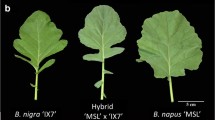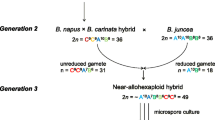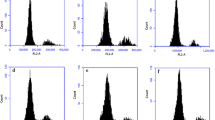Abstract
A synthetic Brassica napus rapeseed with genome composition of ArArCcCc, made by combining Ar from B. rapa (ArAr) and Cc from B. carinata (BcBcCcCc), is valuable for making new genes available to breeders and gaining heterosis in crosses. An intergenomic hybrid AnArCnCc was made from a hybrid between natural Brassica napus (AnAnCnCn) and a synthetic rapeseed. To construct the synthetic Brassica napus, hexaploid plants (2n=54, ArArBcBcCcCc) were first obtained through chromosome doubling of trigenomic hybrids (2n=27, ArBcCc) between Brassica carinata (2n=34) and B. rapa (2n=20). Pentaploid hybrids (2n=46, ArAnBcCcCn) were then produced by crossing the hexaploid with the pollen of natural B. napus (2n=38). Chromosomes with dual and single Bc genomes were observed in somatic cells of hexaploid and pentaploid plants. About 80% of pollen mother cells of pentaploid hybrids had 19 or more bivalents, indicating that the bivalents from Ar/An and Cc/Cn chromosomes were normally formed. The occurrence of trivalents and quadrivalents at diakinesis suggested that Bc, An and Ar or Bc, Cn and Cc homologous pairing and exchange might happen. The variable number of laggards, 3 and 4 in most cases, were observed in the majority of PMCs at anaphase. Results from genomic in situ hybridization showed that the laggards belonged mainly to the Bc genome, suggesting that the Bc genome could be eliminated in the gametesof pentaploid hybrids. 16.15% of seeds derived from self-pollinated pentaploids have 38 chromosomes, and 90% of 38-chromosome seeds were completely excluded Bc genome. The cytological results of this experiment suggested that it is possible to obtain new materials with genome composition of ArArCcCc for rapeseed breeding.
Similar content being viewed by others
References
Akbar MA (1989) Chromosomal stability and performance of resynthesized Brassica napus produced for gain in earliness and short-day response. Hereditas 111: 247–253.
Aslamyousuf M, Bechyne M (1983) Morphology and cytology of F1 hybrids between Brassica napus and B. carinata. SB. VYS. SK. ZEMED Praze-Fakulta Agronomicka 38: 243–253.
Attia T, Busso C, Röbbelen G (1987) Digenomic triploids for an assessment of chromosome relationships in the cultivated diploid Brassica species. Genome 29: 326–330.
Busso C, Attia T, Röbbelen G (1987) Trigenomic combinations for the analysis of meiotic control in the cultivated Brassica species. Genome 29: 331–333.
Chiang MS, Chiang BY, Grant WF (1977) Transfer of resistance to race 2 of plasmodiophora Brassicae from Brassica napus to cabbage (B. oleracea var. capitata). I. Interspecific hybridization between B. napus and B. oleracea var. capitata. Euphytica 26: 319–336.
Chiang BY, Grant WF, Chiang MS (1978) Transfer of resistance to race of plasmodiophora from Brassica napus to cabbage (B. oleracea var. capitata). II. Meiosis in the interspecific hybrids between B. napus and 2x and 4x cabbage. Euphytica 27: 81–93.
Choudhary BR, Joshi P, Ramarao S (2000) Interspecific hybridization between Brassica carinata and Brassica rapa. Plant Breeding 119: 417–420.
Gill RS, Dhaliwal HS, Multani DS (1988) Synthesis and evaluation of Triticum durum-T. monococcum amphiploids. Theor Appl Genet 75: 912–916.
Gómez CC, Prakash S (1999) Origin and domestication. In: Gómez CC, Biology of Brassica Goenospecies. Elsevier Press, 33–58.
Heneen WK, Chen BY, Cheng BF, Jonsson A, Simonsen V, Jørgensen PR, Davik J (1995) Characterization of A and C genomes of Brassica campestris and B. alboglabra. Hereditas 123: 251–267.
Horn P, Rafalski A (1992) Non-destructive RAPD genetic diagnostics of microspore-derived Brassica embryos. Plant Mol Biol Rep 10: 285–293.
Inomata N (1985) Hybrid progenies of the cross. B. campestris × B. oleracea. III. Cytogenetic al studies on F2, B1 and other hybrids. Jpn J Genet 60: 359–371.
Kumar A, Singh P, Singh H, Sharma HC (1984) Difference in osmoregulation in Brassica species. Ann Bot 54: 537–541.
Li Z, Heneen WK (1999) Production and cytogenetics of intergenetic hybrids between the three Brassica diploids and Orychphragmus violaceus. Theor Appl Genet 99: 694–704.
Li ZY, Li MT, Huang RG, Wu XM, Song YC (2002) Genomic in situ hybridization (GISH) discriminates the A, B and C genomes in Brassica allotetraploid species. Chin J Oil Crop Sci 24: 10–14.
Liu HL (2000) Rapeseed Genetics and Breeding. Zhongguo Agricultural University Press, Beijing.
Liu R, Qian W, Meng J (2002) Association of RFLP markers and biomass heterosis in trigenomic hybrids of oilseed rape (Brassica napus × B. campestris). Theor Appl Genet 105: 1050–1057.
Mackay GR (1977) The introgression of S alleles into forage rapa Brassica napus L.from turnip, Brassica campestris L. ssp. rapifera. Euphytica 26: 511–519.
Malik RS (1990) Prospects for Brassica carinata as an oilseed crop in India. Exp Agricult 26: 125–129.
McGrath JM, Quiros CF (1990) Generation of alien chromosome addition lines from synthetic Brassica napus: morphology, cytology, fertility, and chromosome transmission. Genome 33: 374–383.
Meng J, Shi S, Gan L, Li Z, Qun X (1998) The production of yellow-seeded Brassica napus (AACC) through crossing interspecific hybrids of B. campesrtis (AA) and B. carinata (BBCC) with B. napus. Euphytica 103: 329–333.
Nwankiti O (1970) Cytogenetic and breeding studies with Brassica. I. Cytogenetic experiments with Brassica napocampestris. Hereditas 66: 351–386.
Prakash S, Taskahata Y, Chopra V (1999) Cytogenetics. In: Tsunodar S, Hinata K, and Gomez-Campo C, eds. Brassica Crops and Wide Allies, Biology and Breeding. Japan Scientific Soc. Press, Tokyo, 59–106.
Quiros R (1999) Genome structure and mapping. In: Tsunodar S, Hinata K, and Gomez-Campo C, eds. Brassica Crops and Wide Allies, Biology and Breeding Japan. Japan Scientific Soc. Press, Tokyo, 217–245.
Rahman MH (2001) Production of yellow-seeded Brassica napus through interspecific crosses. Plant Breeding 120: 463–472.
Ren JP, Dickson MH, Earle ED (2000) Improved resistance to bacterial soft rot by protoplast fusion between Brassica rapa and B. oleracea. Theor Appl Genet 100: 810–819.
Singh H, Singh D (1987) A note on transfer of resistance to white rust from Ethiopian mustard to Indian mustard. Cruciferae Newslett 12: 95.
Snowdon RJ, Köhler W, Friedt W, Köhler A (1997) Genomicin situ hybridization in Brassica amphidiploids and interspecific hybrids. Theor Appl Genet 95: 1320–1324.
Song YC, Gustafson JP (1993) Physical mapping of 5S rDNA gene complex in rice (Oryza sative). Genome 36: 658–661.
Song KM, Osborn TC, Williams PH (1988). Brassica taxonomy based on nuclear restriction fragment length polymorphism (RFLPs). 1. Genome evolution of diploid and amphidiploid species. Theor Appl Genet 75: 784–794.
U N (1935) Genomic analysis in Brassica with special reference to the experimental formation of B. napus and peculiar mode of fertilization. Jpn J Bot 7: 389–452.
Author information
Authors and Affiliations
Corresponding author
Rights and permissions
About this article
Cite this article
Li, M., Qian, W., Meng, J. et al. Construction of novel Brassica napus genotypes through chromosomal substitution and elimination using interploid species hybridization. Chromosome Res 12, 417–426 (2004). https://doi.org/10.1023/B:CHRO.0000034722.66981.94
Issue Date:
DOI: https://doi.org/10.1023/B:CHRO.0000034722.66981.94




